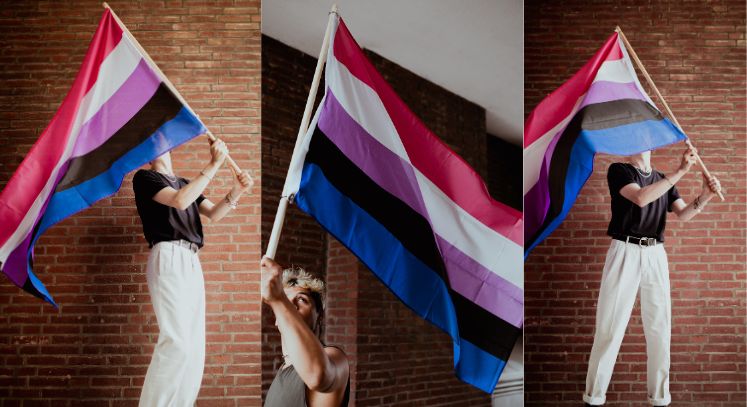Gender-fluid people are people whose gender changes over time and they identify as female one day and male the next. Transgender people feel their identity changing extremely, while others feel that they are arbitrary. Their gender changes in hours or slowly, over months or years.
What is Gender Fluidity?
Gender fluidity conveys a wider and more flexible gender identity range and expression than traditional concepts of male/female gender. People who are gender fluid may:
- Identify as multiple genders at the same time
- Present themselves differently on the gender spectrum at different times
Gender fluid people do not feel confined by restrictive boundaries of stereotypical expectations of men and women. Instead, they travel between genders over weeks, days, or even hours.
Common Terms Related to Gender Fluidity
Here are some useful terms related to gender fluidity:
- Genderflux: Refers to gender identity or expression that shifts between intensity levels on a spectrum, like feeling more powerfully masculine some days and less gendered other days. The shifts happen inconsistently.
- Demifluid: When someone’s gender is usually fluid but stabilized part of the time as a distinct gender, whether man, woman, or non-binary.
- Genderfae: A form of gender fluidity in which someone never fully identifies with a binary male gender, but fluctuates or slides between feminine genders like woman, demi girl, non-binary, etc.
- Genderfaun: A form of gender fluidity in which someone never fully identifies as female, but fluctuates between or slides along masculine genders like man, demi boy, non-binary, etc.
- Abrosexual: Referring to an individual whose sexuality is changing or fluid over time. Common among gender-fluid people, since gender identity and sexuality often intersect for people.
- Gender euphoria: The happiness, comfort, and authenticity felt when able to present or be recognized as one’s true gender identity after a period of “gender dysphoria” – the distress caused by the inability to express one’s identity.
Remember, people who are gender fluid may move between genders, identify with multiple genders, or reject the gender binary. Their inner sense of gender may not match their outward presentation.
What Causes Gender Fluidity?
Experts do not know definitively what leads to fluidity in gender identity and/or expression. As with many aspects of human diversity, biological and social/cultural factors likely play an interactive role.
Potential influences on the development of gender fluidity include
- Genetics and prenatal hormone exposure, which shape the architecture and connectivity of the brain
- Social and relational experiences in childhood, which shape gender identity and determine available models for gender diversity
- Cultural context regarding acceptable behaviors and opportunities for people of diverse gender identities.
In some societies, gender fluidity has been accepted and even revered. Many Indigenous American and South Asian cultures traditionally recognize “two-spirit” people who fluidly traverse masculine and feminine worlds and responsibilities.
Signs of Gender Fluidity
There is no one way to be gender fluid. Some signs that may indicate gender fluidity in yourself or a loved one include:
- Frequently questioning or changing gender identity and expression over time
- Exploring different pronouns and gender expressions
- Not feeling satisfied with the gender binary of male/female or man/woman
- Expressing gender differently across various contexts – home, work, recreation. For example, dressing or behaving more feminine some days and more masculine other days
- Not conforming consistently to gender stereotypes associated with the sex assigned at birth
Challenges
Here are some challenges gender fluid people may face about their identity:
- Relationship struggles: Partners of gender fluid people may struggle to accept shifts in gender expression or identity, especially if they are not well-versed in gender diversity. This can strain intimate relationships.
- Bathroom access: Gender-fluid people may face harassment, confusion, or anxiety regarding which public bathrooms they are “allowed” to use based on how they are presenting at any given time.
- Healthcare barriers: Doctors or psychologists may be insensitive to gender diversity or lack training to provide gender-affirming care. Gender-fluid people also face obstacles to getting insurance coverage for procedures based on shifting identities.
- Difficulty transitioning: Some gender-fluid people may want to transition medically/socially to align their body and gender expression with internal identities. But traditional transition processes are designed for static binary identities, not fluid ones.
- Job discrimination: Employers may fire staff who shift gender presentation “too much” if they are uncomfortable accommodating flexible gender diversity in the workplace.
- Chosen family: If biological family members reject them, some gender-fluid people rely heavily on friendships and community connections for critical social support. But constantly having to explain one’s changing identity can tax those bonds.
Unfortunately, many societal hurdles prevent gender-creative people from thriving as their whole selves.
Supporting the Gender-Fluid Community
If you have a gender-fluid loved one in your life or want to ally with the gender-creative community, here are some tips:
- Accept them unconditionally. Affirm their feelings and experiences. Believe them about their gender identity – even when it changes or puzzles you.
- Be willing to get comfortable with discomfort. Learning to understand gender diversity takes openness, empathy, and compassion.
- Don’t expect them to educate you. Do your research into gender fluidity. Seek to understand terminology and turn to experts – not your gender-fluid friend or child.
- Allow flexibility around gender expression. Understand that it may change regularly – and that does not take away from the authenticity of each gender presentation.
- Advocate for gender fluid rights. Vote for candidates who will protect gender-fluid people. Speak up against discriminatory policies, jokes, and behaviors.
Remember, no one can tell someone else what their gender identity is.
Conclusion
Gender fluidity conveys a wider range of gender identity and expression than society typically allows for. People who are gender fluid move flexibly along the masculine-feminine spectrum over their lifetime or even day-to-day.
Gender-fluid people face discrimination and unique difficulties in finding acceptance. But with understanding and support from loved ones, gender-creative individuals feel safe bringing their authentic selves into the world. So, you should welcome the spectrum of human diversity without fear. People of all gender identities deserve to feel seen, affirmed and understood.
FAQs
Is Gender fluid the same as Transgender?
No. Transgender identities typically convey a lasting transition from one gender to another that feels truer for the individual. Gender fluidity conveys a flexible shifting between the masculine and feminine spectrum.
How can I support my gender-fluid family member?
Provide unconditional love while seeking your education on gender diversity. Make your home a safe space for them to explore fluidity in gender expression. Speak up against gender discrimination in your community. Connect them with gender-affirming resources and support groups.
Should I ask a gender-fluid person about the changes in their identity?
It’s usually best not to ask unprompted, personal questions about someone’s gender identity unless they open that conversation. Focus instead on affirming their expressed identity at any given time and educating yourself on your own. If they want to share more about their experience of fluidity with you, they will when ready.







